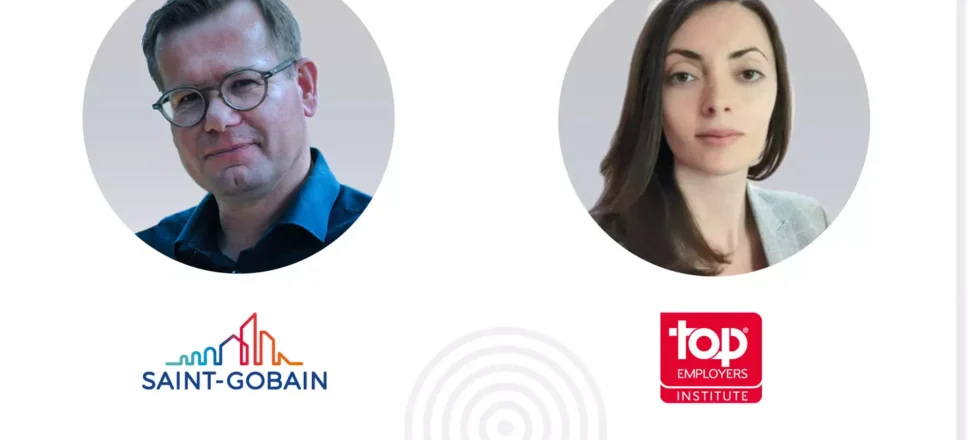How can HR analytics and specifically big data be used for talent management?
That is what exactly Certified Top Employer Saint-Gobain discussed in a recent Top Employers Connect webinar. In the latest of our ‘For a Better World of Work’ series, we were joined by Jan Billekens, Manager Group HR Efficiency at Saint-Gobain and Alissa Hankache, Ph.D., Global HR Auditor at Top Employers Institute.
Read ahead to get a snapshot at some of the highlights from the webinar and fill in the form (on the right-hand side of the page) to get the recording to watch whenever you have a moment.
Companies use AI in people-related decisions for many reasons, including consistency, reduced bias, casting a broader net, and efficiency.
Data scientist Cathy O’Neil explains in her book “Weapons of Math Destruction” that algorithms and AI are easy to create using historical data and can improve the efficiency of decision making.
Data from TEI shows that among certified companies:
- In 87% of cases, HR supports business with people analytics.
- And in 88% of cases, business leaders are committed to using HR data analytics for fact-based decision-making about the workforce.
Approaching HR with analytics
With more than 166,000 employees, located in 75 countries, and a shared purpose of “MAKING THE WORLD A BETTER HOME”, Saint-Gobain is certified as a Global Top Employer since 2016. After internal reflection and deliberation, Saint-Gobain was left with one big question:
“How can we use big data for talent management in a global and highly decentralized industrial matrix organization like Saint-Gobain?
Based on this, the following objectives were established:
- Identify Talents
- Targeted development and career support
- Developing leadership capabilities
Ensure retention and commitment
An approach with three steps was then developed for the HR analytics project at Saint-Gobain:
- Assess Bronze Talent management
- Identify Talents at risk of leaving
- Identify undiscovered Saint-Gobain talents
Assess Bronze Talent Management
The first phase was to look at emerging trends from the algorithm, which came through as follows:
- Career progression – The algorithm has identified that talents within the five years at Saint-Gobain climb two-thirds bands more than non-talents.
- Career follow-ups – In annual succession planning and [erformance reviews, talents were mentioned more often in people reviews than non-talents.
- Development and training opportunities, – Talents have more training opportunities than non-talents.
- Base salary management – Salary increases are higher for talents than-non talents.
- Increasing gender balance – The % of female hired talents is 6% higher than male talents hired – based on strategic objectives.
The conclusion of this first part is that it confirmed that “what we want to do with our talent management is being achieved”.
Identify talents at risk of leaving
The second algorithm – looked into the past and analysed what were the elements of talents who left Saint-Gobain voluntarily in the past. The most impactful parameters were salary increase percentage and the date of last increase. The lower the salary increase, the higher the risk of leaving – no surprise, but it is also confirmed by the algorithm.
An interesting trend emerged when looking at tenure – when the last increase for a salary was between 6 months and 1.5 years, there is a lower risk of leaving. But after 1.5 years of a lower salary increase, there is a higher risk of leaving. The algorithm provided a percentage of the risk of leaving talent – about 150 names. These were then sent to country HRDs with all the parameters of risks included. They were asked to provide feedback on whether there was a risk of leaving or not (and at various levels of risk). Based on a combination of input from the algorithm, and feedback from HRDs – 100 of the 150 employees were able to be retained. Managers were able to take proactive actions to prevent employees from leaving.
Identifying undiscovered Saint-Gobain Talents
One of the interesting components of the webinar was to note how Saint-Gobain uses an algorithm to identify undiscovered talents. Part of the diagram, was important to understand:
- Precision – % of true SG Talents among the Talents identified by the algorithm
- Recall – % of Talents identified by the algorithm among the SG Talents
After consultation with and feedback from country HRDs on the 250 names proposed by the machine, 115 Bronzes talents were detected!
The webinar also discussed various other aspects of HR analytics including:
- Data visualization
- Semantic Analysis
- Data integrity
- Data confidentiality
The key message echoed throughout the session is that HR Analytics is a means besides all other HR tools. HR should take advantage of these digital tools in order to spend more time meeting people face to face
